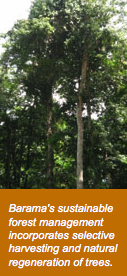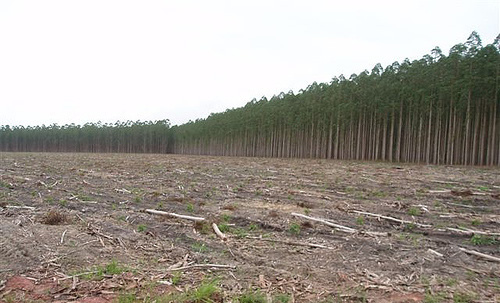There are many forest certification schemes. However, most "certify the current status quo of forest management, which in most cases does not earn the label 'from well managed forests'". This is often because the forest industry is too close to the certifiers.
Moreover, many consumers assume that certification solves the many problems associated with forestry. "Such perception makes it more difficult for NGOs to create awareness about the many problems that still exist in forest management."
 The only certification scheme that has the broad support of environmental groups is that of the The Forest Stewardship Council (FSC) which is also one of the few that sets performance-based standards. It is "funded by accreditation and membership fees, governments, environmental organisations and private foundations".
The only certification scheme that has the broad support of environmental groups is that of the The Forest Stewardship Council (FSC) which is also one of the few that sets performance-based standards. It is "funded by accreditation and membership fees, governments, environmental organisations and private foundations".
The FSC is a non-profit organisation established in 1993 by WWF whose goal is the responsible management of forests worldwide bysetting standards and certifying forestry so that consumers can choose products that have been sourced from well-managed forests. By June 2013 it had certified 180 million hectares of forest.
Our members include some of the world’s leading environmental NGOs (WWF and Greenpeace), businesses (Tetra Pak and Mondi PLC) and social organizations (the National Aboriginal Forestry Association of Canada) , as well as forest owners and managers, processing companies and campaigners, and individuals.
The participation of big name environmental groups helps to overcome the scepticism the public has towards forest certification schemes. However environmental support has been falling away in recent years. For example, in 2008 Friends of the Earth England, Wales and Northern Ireland (FoE EWNI), one of the founders of FSC, announced that it no longer recognised the value of FSC certificates: "We cannot support a scheme that fails to guarantee high environmental and social standards".
Sylvain Angerand, who heads the forest campaign for Friends of the Earth in France, says Angerand, "the scheme gives legitimacy to the industrial management of forests by shifting responsibility from public authorities to private outfits; it is largely used for its image value and 'greenwashes' many private ventures."
The FSC gives accreditation to other organisations to assess forestry operations and approve certification. According to Simon Counsell, who had been involved in establishing FSC and then helped to found FSC-Watch, and now director of The Rainforest Foundation, UK:
‘In 2002 we had already noticed that in order to get business, certifiers were competing with each other. The most successful are the most generous and lenient, turning a blind eye to breeches in FSC requirements. I've seen cases where logging companies have switched certifiers. This happens everywhere.
This has led, says Counsell, to "certificates were being issued to companies that had a very poor environmental and social record". Because this has repeatedly occurred without serious consequence "the certifiers now know that they can continue with impunity to earn their certification fees even when they issue FSC certificates to companies that are egregiously breaching the FSC's rules."
In 2006 Barama, the Guyanese subsidiary of the controversial Malaysian-based logging tra nsnational, Samling, was certified as FSC compliant by SGS-Qualifor, which at the time was responsible for about 20% of FSC certificates. It was FSC’s largest certificate for tropical forest management up to that time and WWF had provided Barama with technical and financial support to attain the certification.
nsnational, Samling, was certified as FSC compliant by SGS-Qualifor, which at the time was responsible for about 20% of FSC certificates. It was FSC’s largest certificate for tropical forest management up to that time and WWF had provided Barama with technical and financial support to attain the certification.
However within a year it was apparent that Barama was not complying with its certification conditions. It had been certified by SGS without any forest management plan in place, nor procedures for undertaking environmental impact assessments, problems recognised by peer reviewers but ignored by SGS. Its FSC certification was then withdrawn.
In fact, the announcement [of FSC certification withdrawal] provides interesting insights into both SGS and the FSC, as it has revealed a long string of major failures by SGS to perform as required under the FSC’s rules. The FSC found that a "lack of appropriate evaluation against FSC certification requirements has resulted in systematic major nonconformities which had not been addressed."
The FSC's certification of plantations has been a major source of criticism.
Plantations are monocultures, created from seemingly endless rows of identical trees. They suck the water out of nearby streams and ponds and lower the water table, leaving little or no water for people living near the plantations. They deplete soils, pollute the environment with agrotoxics and eradicate biodiverse local ecosystems. Activists in Brazil call them the green desert because of the way they destroy local people’s livelihoods and environments.
In 2008 the World Rainforest Movement (WRM) criticised the FSC's certification of eucalypt plantations in Brazil owned by Veracel calling FSC's "death certificate". The WRM claimed that Veracel "has a very well known record of harmful actions, including violating local communities' rights over land, to environmental pollution, water depletion and ecosystem destruction."
A few months later nearly one hundred thousand hectares of Veracel's eucalyptus plantation was found to be planted illegally and ordered to be torn down within 12 months. "The company has also been ordered to pay $12 million in fines for causing environmental damage".
The WRM argued that to certify plantations the FSC was endorsing large-scale monoculture plantations as environmentally sound and socially responsible when in fact they support little biodiversity, do not absorb as much CO2 as natural forests and undermine local efforts toward sustainable forestry. The WRM claimed that "The certifying company itself (SGS) has a long record of certifying uncertifiable large scale industrial tree plantations" and that "the certification of Veracel is not an isolated fact, but the last piece in a chain of failures."
In 2011 the FSC, with the support of Greenpeace, voted to certify as sustainable, plantations established on the site of cleared primary rainforests and other old forests.These had previously been excluded from certification so as not to promote conversion of old growth forests to plantations.
Some environmental groups argue that no old growth forest can be logged in a sustainable way. Others that the problem lies with considering each logging operation in isolation rather than considering the impact of multiple logging operations on rainforest ecology:
Primary forests logged industrially for the first time – FSC certified or otherwise – are destroyed. What remains is permanently ecologically diminished in terms of composition, structure, function and dynamics. Logged primary forests' carbon stores, biodiversity and ecosystems will never be the same in any reasonable time-span. Selective, industrially logged rainforests become fragmented, burn more and are prone to outright deforestation...
Best estimates from two independent studies are FSC has already certified the first time industrial logging of sixty-five million hectares (about 150 million acres) of primary and old-growth forests, and an equal amount is threatened in FSC's plans for coming years. These 130,000,000 hectares are nearly 460,000 square miles of primary and other old forests destruction – an area the size of South Africa, or nearly two times the size of Texas!
Groups such as Ecological Internet  argue that certified forests should be neither monoculture plantations nor old growth forests but rather come from:
argue that certified forests should be neither monoculture plantations nor old growth forests but rather come from:
Certification encourages more use of timber and paper products rather than reduced use and consumption which would be necessary to maintain old growth forests and avoid damaging monoculture plantations.
Ecological Internet claims that environmental groups WWF, Greenpeace and the Rainforest Action Network (RAN) and others originally supported FSC "expecting it would reduce logging of primary and old growth forests, and result in more community based eco-forestry". Instead FSC has enabled industrial logging to continue unabated in old growth forests "with minor, cosmetic changes" and the greenwash of the FSC logo.
Others argue that FSC has in fact given governments and large forestry companies an advantage over smaller community-based forestry enterprises, which cannot afford the expense of certification.
Another problem is the way that FSC certifies forest products from 'mixed sources', which
allows up to 90% of the wood fibre in some FSC-labeled products to come from forests or plantations that are not actually FSC-certified, but are supposedly 'controlled sources'. The truth is that these sources are not 'controlled' at all - and hence many FSC products are likely to include material that is from illegal operations, or felling in High Conservation Value forests, or areas that are claimed by indigenous people. The Mixed Sources policy is allowing the laundering of unacceptable wood into the FSC system.
Counsell claims that the FSC complaints mechanism does not work:
In the late 1990s, the Rainforest Foundation worked with Indonesian NGOs to bring a formal complaint to the FSC about a certificate that had been awarded to a company logging in the rainforests of Sumatra. We had much evidence, verified by on-the ground inspection and detailed in reports and video, that there were many problems with the company, including illegal timber felling, and conflicts with local communities. The complaint took four years to go through the FSC process — and only then resulted in the FSC agreeing to do more monitoring. It remains certified...
There is no way that most NGOs, especially in developing countries, could sustain such a long and expensive complaint process. The process is heavily stacked in favour of the certifiers and their forestry clients. The FSC has never, to my knowledge, cancelled a certificate as a result of a complaint...
According to Counsell, rather than certification, "What is needed is closer government regulation of how forests are used" and for consumers to use less forest products, not more certified forest products.